Spiritual Symbols and What They Mean: Ankh!
Spiritual symbols serve as important cultural and religious touchstones, providing insight into the esoteric wisdom and shared human consciousness.
Symbols like the Ankh, the Om, the Cross, and the Tree of Life carry deep meanings, spanning from eternal life to the unity of existence and the balance of nature.
Spiritual symbols are visual representations that encapsulate complex spiritual concepts and beliefs.
Each symbol is steeped in history and holds unique significance across various cultures and religions. For example, the Ankh is an ancient Egyptian hieroglyph representing life and immortality.
Here are some well-known spiritual symbols:
- Ankh: Symbolizes life, immortality, and the universe’s breath.
- Om: Represents the sacred sound of the universe and spiritual perfection in Hinduism.
- Cross: Central to Christian faith, symbolizing sacrifice, salvation, and atonement.
- Tree of Life: Found in numerous cultures, it symbolizes growth, interconnectedness, and enlightenment.
Delving into spiritual symbols unveils layers of profound wisdom, allowing individuals to connect with ancient traditions and the essence of their spirituality.
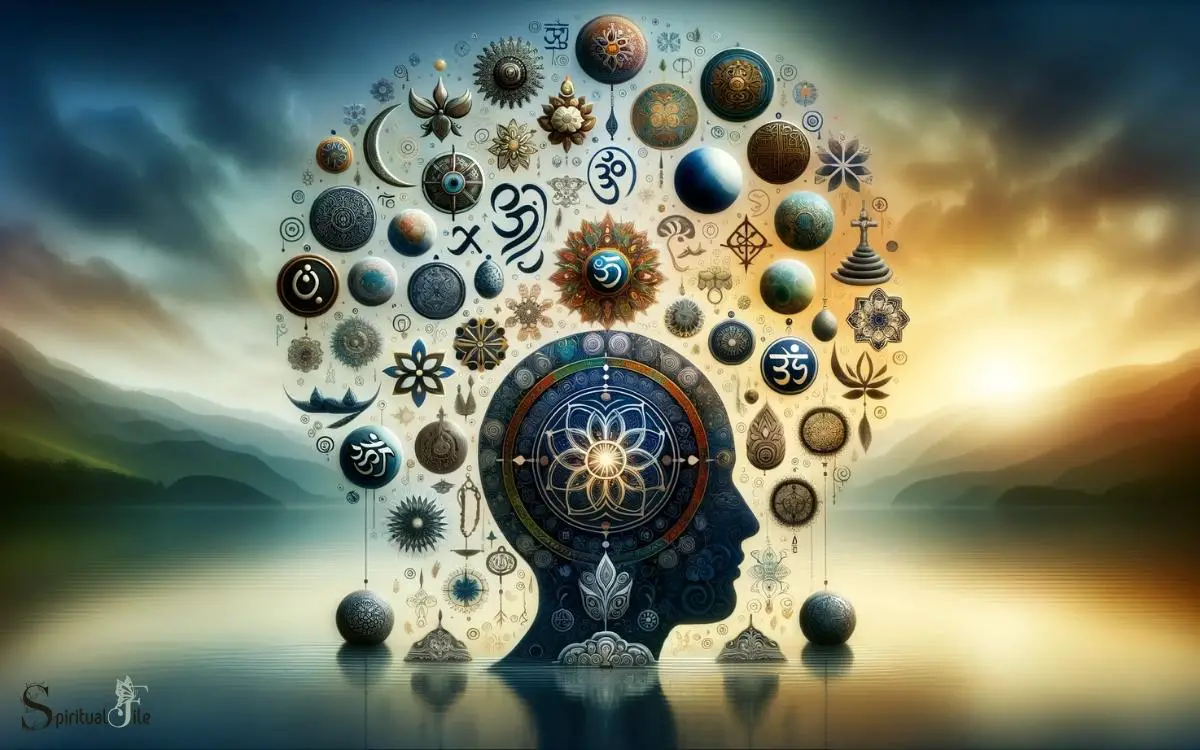
Key Takeaway
Understanding Spiritual Symbols and Their Meanings – A Guide
| Symbol | Origin | Meaning | Common Usage |
|---|---|---|---|
| Om (ॐ) | Hinduism | Represents the universe and ultimate reality, the sound of the cosmos | Meditation, yoga, religious texts |
| Cross (†) | Christianity | Symbolizes the crucifixion of Jesus Christ, representing faith and redemption | Jewelry, churches, religious texts |
| Star of David (✡) | Judaism | Emblem of the Jewish people, associated with protection and the connection between God and Israel | Jewelry, synagogues, flags |
| Crescent Moon and Star (☪) | Islam | Represents the connection to the divine, guidance, and the Islamic community | Flags, mosques, decorations |
| Yin and Yang (☯) | Taoism/Daoism | Symbolizes balance and duality in nature; interdependence of opposing forces | Art, philosophy, feng shui |
| Khanda (☬) | Sikhism | Represents divine knowledge, the oneness of God, and the balance of moral duty | Flags, religious texts, emblems |
| Lotus Flower | Various Traditions | Signifies purity, enlightenment, and rebirth | Art, spiritual practices, décor |
| Wheel of Dharma (☸) | Buddhism | Represents the teachings of the Buddha, the path to enlightenment | Temples, art, religious texts |
| Ankh (☥) | Ancient Egypt | Symbol of life, immortality, and the universe; also considered a key of the Nile | Jewelry, hieroglyphs, art |
| Pentagram (⛤) | Pagan/Wicca | Represents the elements and the spirit, also used as a symbol of protection | Rituals, amulets, flags |
The Yin and Yang Symbol

The Yin and Yang symbol represents the concept of dualism and the interdependence of opposing forces in the spiritual and philosophical traditions of East Asia.
This iconic symbol embodies the idea that seemingly contrary forces are interconnected and interdependent in the natural world.
The black side, Yin, embodies qualities such as darkness, femininity, and passivity, while the white side, Yang, represents light, masculinity, and activity.
The circle in which they are encased symbolizes the dynamic balance between these forces, illustrating how they are not static but constantly transforming into one another.
This concept is integral to various aspects of East Asian culture, including traditional Chinese medicine, martial arts, and Feng Shui.
The Yin and Yang symbol serves as a reminder of the harmonious coexistence and balance of opposing forces in the universe.
The Sacred Lotus Flower
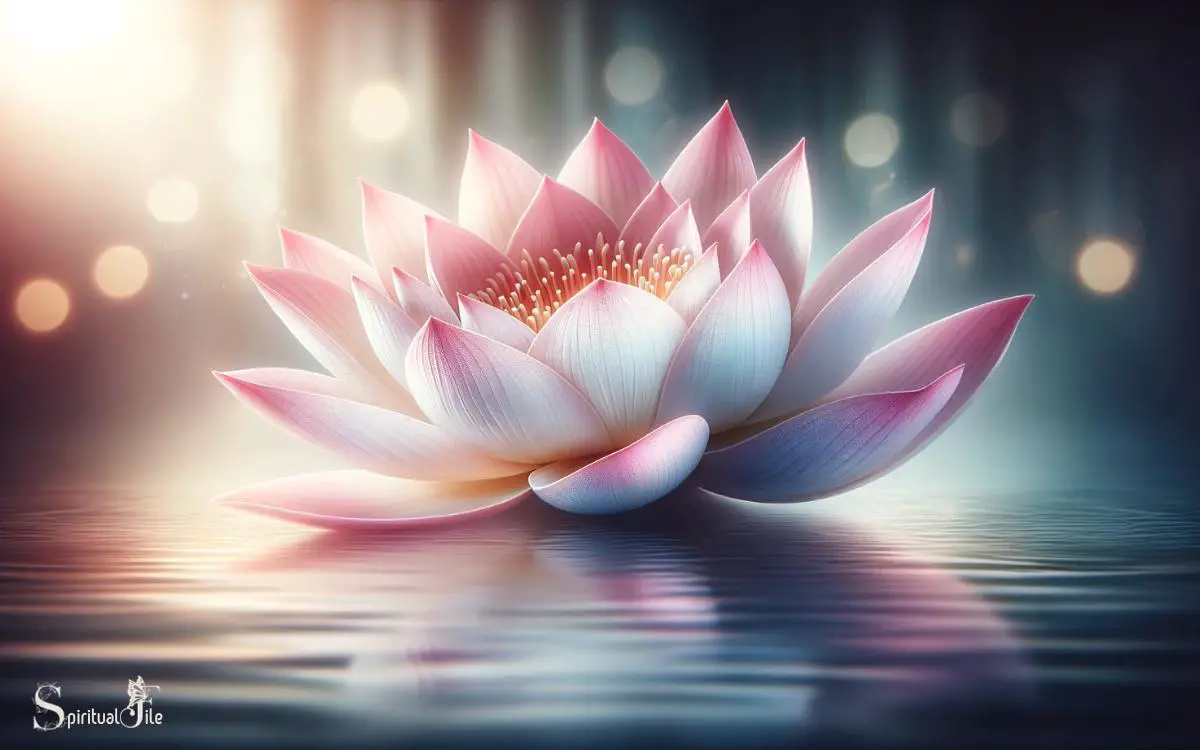
The lotus flower is a powerful spiritual symbol known for its association with purity and enlightenment. Its cultural significance spans across various traditions and is revered for its ability to rise from the murky depths to bloom into a beautiful, untarnished flower.
Additionally, the lotus holds a prominent place in different religions, symbolizing spiritual growth and the journey towards enlightenment.
Lotus as Purity Symbol
The lotus flower symbolizes purity and enlightenment in many spiritual traditions.
It holds deep significance in various cultures and religions, representing the following:
- Purity: The lotus grows in muddy water, yet it remains pure and untouched by the impurities around it, symbolizing purity of body, speech, and mind in the midst of the worldly challenges.
- Resilience: Despite its origins in muddy waters, the lotus blooms each day, signifying resilience in the face of adversity and the ability to rise above difficulties.
- Enlightenment: The unfolding petals of the lotus represent the expansion of the soul and spiritual awakening, signifying the journey from darkness into light.
The lotus, with its rich symbolism, holds a significant place in the cultural and spiritual practices of many societies.
Cultural Significance of Lotus
Cultural significance of the lotus flower spans across various societies and spiritual traditions, reflecting its profound importance in cultural practices and beliefs.
In Hinduism and Buddhism, the lotus is revered as a symbol of purity, enlightenment, and rebirth. Its ability to emerge from murky waters and bloom into a beautiful flower has made it a metaphor for overcoming obstacles and achieving spiritual growth.
In ancient Egyptian culture, the lotus was associated with the sun and rebirth, often depicted in art and mythology.
Similarly, in Chinese and Japanese traditions, the lotus holds symbolic meanings of purity, perfection, and spiritual awakening.
The widespread cultural significance of the lotus illustrates its enduring impact on human consciousness and spirituality, transcending geographical and religious boundaries.
Lotus in Different Religions
- Hinduism: In Hindu mythology, deities are often depicted sitting on lotus flowers, symbolizing divinity and purity.
- Buddhism: The lotus is a symbol of purity, enlightenment, and detachment, as it emerges from murky waters unspoiled.
- Ancient Egypt: The lotus flower, particularly the blue lotus, was associated with the sun and rebirth, often depicted in ancient Egyptian art.
The lotus flower’s widespread presence in various religious and cultural contexts highlights its universal significance as a symbol of spiritual growth and transformation.
This makes it an emblem of profound importance in understanding the spiritual and cultural landscape of different civilizations.
The lotus is a powerful symbol, transcending geographical and religious boundaries, connecting humanity through its deep spiritual meanings.
The Mysterious Ankh
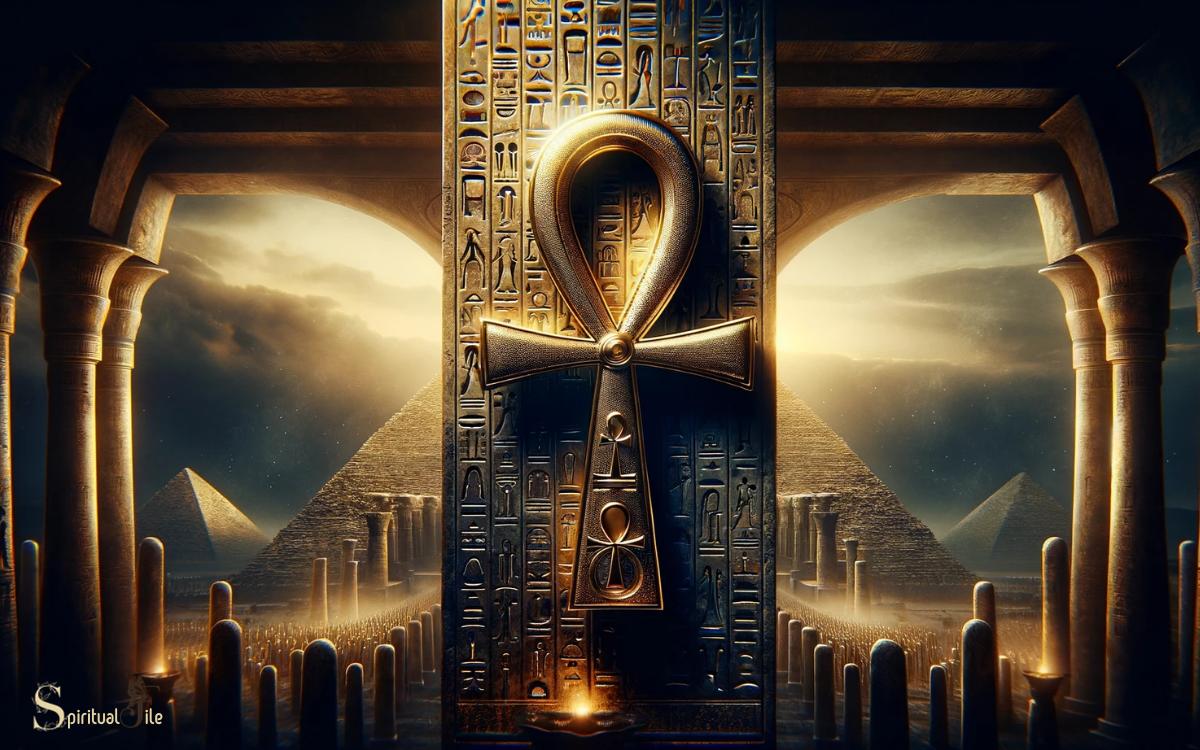
The enigmatic symbol of the Ankh holds a deep and ancient significance, dating back to ancient Egyptian civilization. It is widely recognized as a cross with a loop at the top, representing life and immortality.
In modern culture, the Ankh continues to be a powerful symbol, often associated with spirituality and eternal life.
Ankh’s Ancient Significance
What is the ancient significance of the mysterious Ankh? The Ankh, an ancient Egyptian symbol, holds deep meaning and significance.
Its ancient importance can be understood through three key points:
- Symbol of Life: The Ankh represents the concept of life, both physical and eternal. It is often depicted being held by gods and pharaohs, signifying their ability to give and sustain life.
- Spiritual and Cosmic Connection: The looped cross is believed to epitomize the union between the male and female, representing the harmonious balance essential for creation and the interconnectedness of the spiritual and earthly realms.
- Divine Protection and Immortality: The Ankh was also associated with divine protection and immortality, with its shape resembling a key that could unlock the gates of the afterlife, ensuring a soul’s eternal existence.
The Ankh’s ancient significance encompasses profound spiritual and existential concepts that continue to intrigue and inspire.
Ankh as a Cross
Representing an enigmatic fusion of spiritual and cultural significance, the Ankh symbolizes profound mysteries and enduring spiritual connections. One of the most intriguing interpretations of the Ankh is its association with the concept of a cross.
In ancient Egyptian culture, the Ankh was often depicted as a cross with a loop at the top, representing life and immortality. This unique blend of cultural and spiritual meanings has fascinated scholars and enthusiasts for centuries.
The Ankh as a cross serves as a powerful reminder of the interconnectedness of life and the eternal nature of the human spirit.
| Aspect | Description |
|---|---|
| Origin | Ancient Egypt |
| Symbolism | Life, immortality |
| Cultural Significance | Enduring spiritual connections |
Ankh in Modern Culture
In modern culture, the Ankh continues to captivate the imagination, symbolizing a timeless connection to life, spirituality, and enduring mysteries.
Despite its ancient origins, the Ankh remains a prevalent symbol in various aspects of modern society.
- Fashion: The Ankh is frequently incorporated into jewelry and clothing designs, embraced by individuals seeking to express their spiritual beliefs or simply drawn to its aesthetic appeal.
- Tattoos: Many people choose to ink their bodies with the Ankh as a permanent symbol of life, vitality, and spirituality.
- Pop Culture: The Ankh has made appearances in literature, movies, and music, further solidifying its place in modern culture and its enduring allure. Its enigmatic nature continues to spark curiosity and fascination, making it a symbol that transcends time and culture.
The Enigmatic Mandala
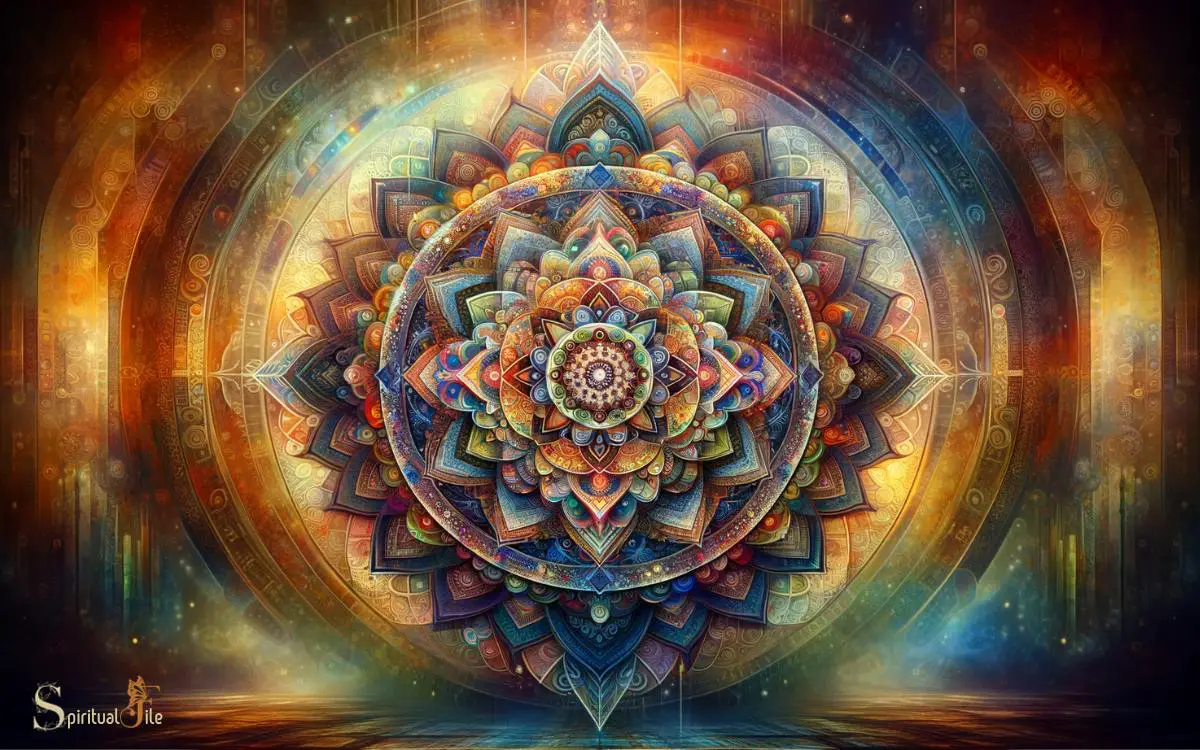
The enigmatic mandala, originating from the Sanskrit word for ‘circle,’ holds deep spiritual significance in various cultures and religions.
Representing the universe and wholeness, mandalas are intricate geometric designs that symbolize harmony and unity.
In Hinduism and Buddhism, they are used as meditation aids, guiding individuals towards spiritual awakening and enlightenment.
The circular shape of the mandala signifies the cyclical nature of life and the universe, while its intricate patterns represent the interconnectedness of all beings.
Mandalas are also seen in Christianity, Native American traditions, and other belief systems, embodying spiritual and ritualistic meanings.
The practice of creating or meditating on mandalas is believed to help individuals connect with the divine and attain inner peace.
The All-Seeing Eye
Moving from the enigmatic mandala to the all-seeing eye, we transition to a symbol that holds significant spiritual meaning across various cultures and belief systems.
The all-seeing eye, often depicted as an eye enclosed within a triangle, represents divine omniscience, inner vision, and insight into the unseen.
This symbol is commonly associated with concepts of enlightenment, knowledge, and the presence of a higher power.
Across different cultures, it is seen as a symbol of protection, wisdom, and the ability to perceive the truth beyond the physical world.
The Powerful Om Symbol
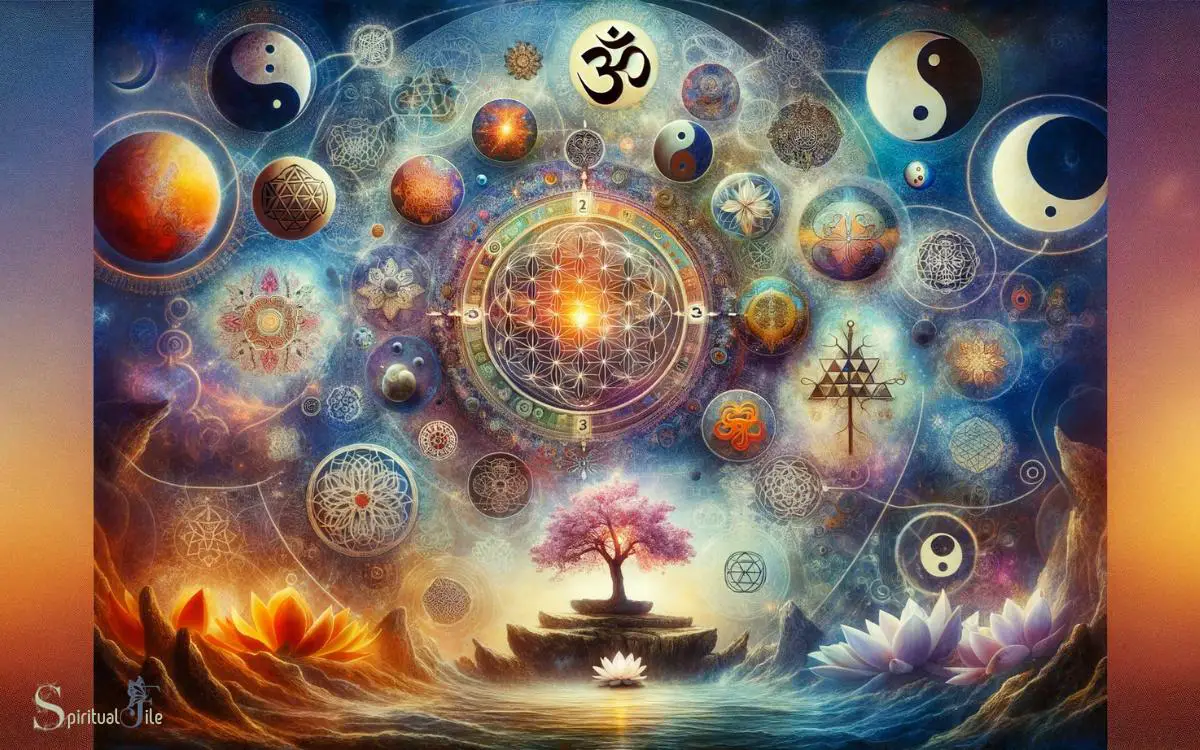
Transitioning from the all-seeing eye, we now delve into the powerful Om symbol, a deeply significant spiritual emblem across various traditions and practices.
Om, often chanted at the beginning and end of yoga sessions, is considered the sound of the universe.
In Hinduism, it represents the three realms of existence – earth, atmosphere, and heaven, as well as the three divine forces – creation, preservation, and destruction.
The symbol’s visual representation consists of three curves, a semicircle, and a dot, each carrying profound meaning.
The curves signify the waking, dreaming, and deep sleep states of consciousness, while the dot represents the transcendental state, which is the source of all existence.
Understanding the rich symbolism behind Om can deepen spiritual practice and foster a greater sense of connection with the universe.
The Serene Tree of Life
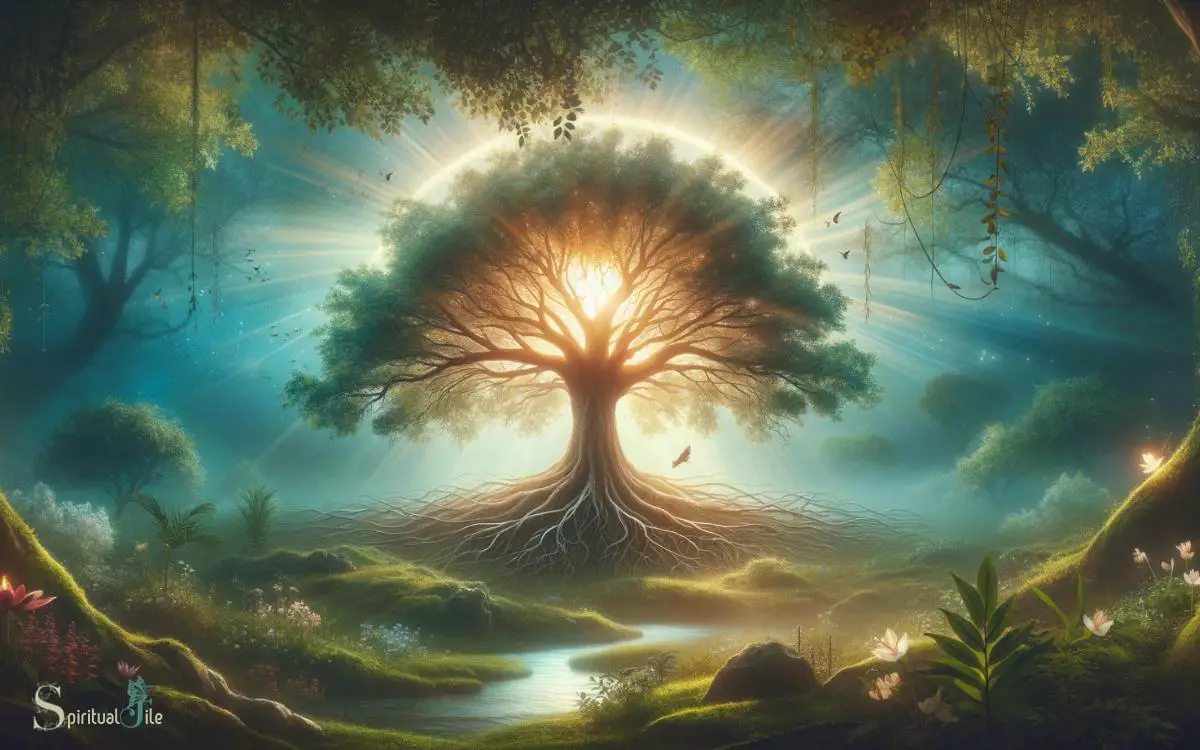
Continuing from our exploration of profound spiritual symbols, we now turn our attention to the significance of the Serene Tree of Life, a symbol that encapsulates the interconnectedness and vitality of existence.
The Tree of Life represents:
- Interconnectedness: The branches and roots of the tree symbolize the interconnectedness of all life forms, highlighting the fundamental unity of the universe.
- Vitality and Growth: It signifies the cycle of life, growth, and rebirth, reflecting the resilience and strength found in nature.
- Spiritual Nourishment: The tree’s fruits and leaves represent spiritual nourishment and the abundance of the universe, offering sustenance for the body, mind, and soul.
This symbol serves as a powerful reminder of our connection to all living beings and the cyclical nature of existence.
What Spiritual Meaning Does the Ankh Symbolize?
The Ankh, an ancient Egyptian symbol, holds profound keys spiritual symbolism revealed. It represents life, immortality, and the union of male and female energies. The loop symbolizes eternal life, while the cross represents the earthly plane. Together, they signify the balance and interconnectedness of life and death.
The Mystical Triskele Symbol
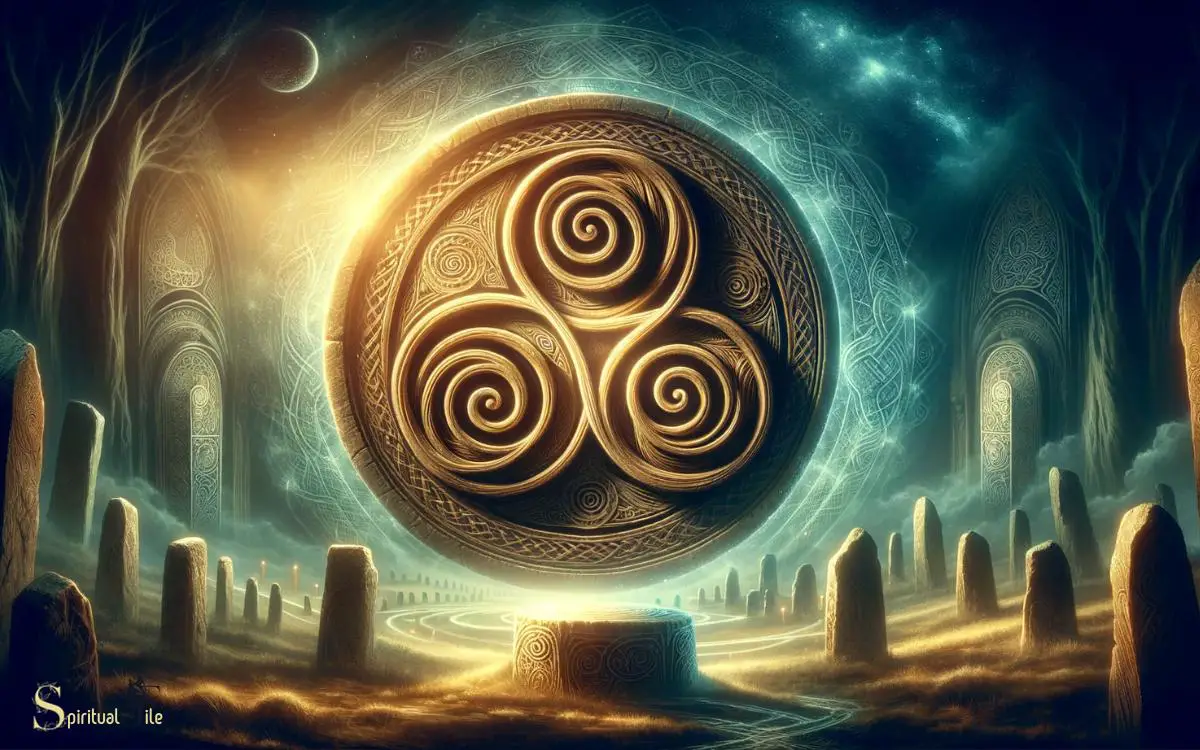
The Mystical Triskele symbol holds profound significance in spiritual symbolism, embodying a complex interplay of threefold aspects within various cultural and spiritual contexts.
The triskele, also known as the triple spiral, is a symbol comprised of three interlocked spirals or three bent human legs. It is commonly associated with themes of cycles, progress, and continuous motion.
The table below illustrates the diverse interpretations of the triskele symbol across different cultures:
| Culture | Meaning |
|---|---|
| Celtic | Land, sea, and sky |
| Christianity | Holy Trinity |
| Neopaganism | Maiden, mother, crone |
| Greek | Past, present, future |
| Isle of Man | Sun, water, earth |
The triskele’s enduring presence across various belief systems and cultures underscores its universal significance as a representation of interconnectedness and the cyclical nature of existence.
Conclusion
Spiritual symbols hold deep meaning and significance in various cultures around the world. From the balance of Yin and Yang to the enlightenment of the Lotus Flower, each symbol represents a unique aspect of spirituality and the human experience.
Just as these symbols intertwine and connect, so too do the diverse beliefs and practices of individuals seeking spiritual understanding.
Like a tapestry of interconnected threads, these symbols weave a rich and complex tapestry of human spirituality.






